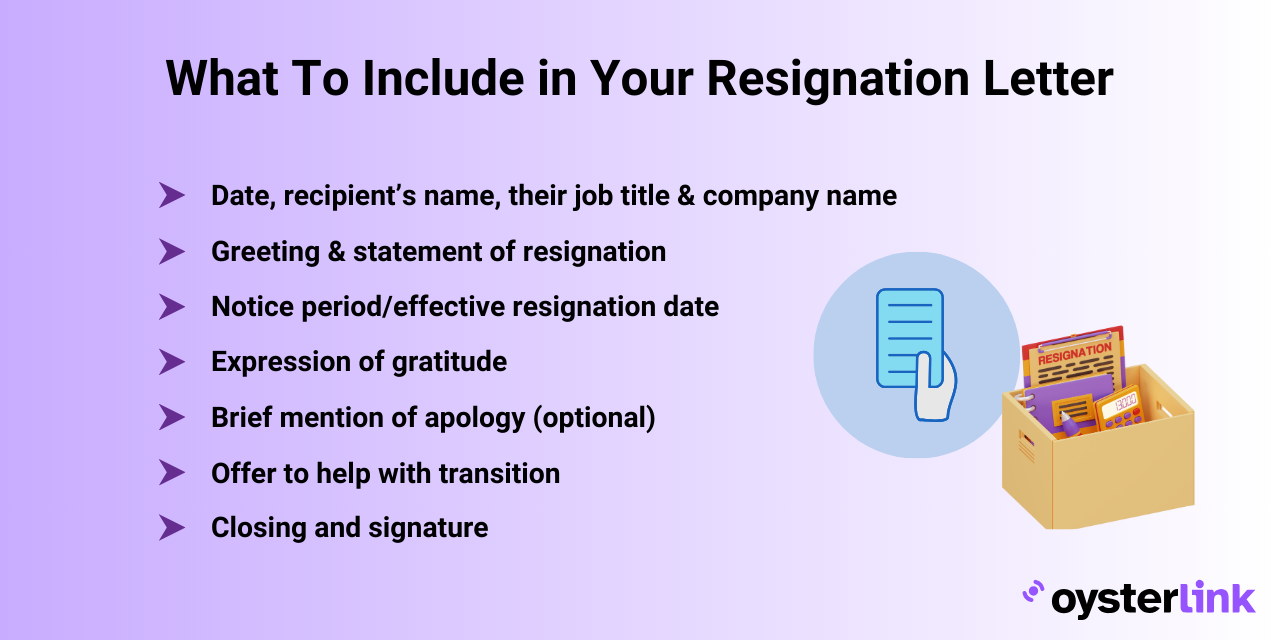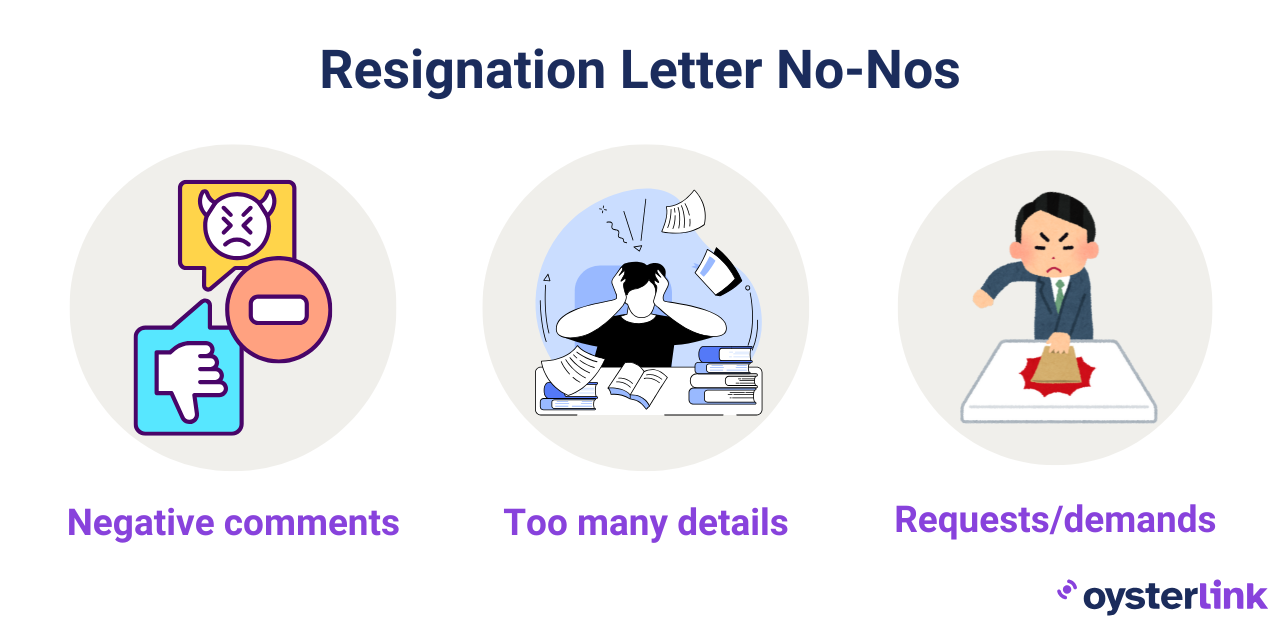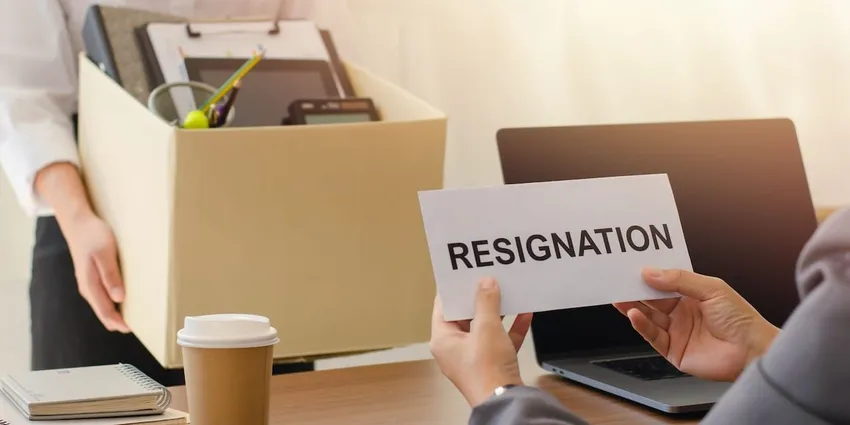In this article, we provide resignation letter templates, tips on what to include in your resignation letter and what to avoid including if you decide to write one yourself.
3 Resignation Letter Templates
Below are three resignation letter examples – each with a specific tone and voice. That way, you can convey your decision with the level of professionalism, urgency and warmth that best suits your situation.
Template 1: Short and Simple Professional Resignation Letter
Contrary to what you might’ve heard, a simple or short resignation letter doesn’t necessarily mean it’s unprofessional. As long as it’s respectful and clearly communicates your intention to leave, a brief letter can still convey the message effectively. Below is a resignation letter example that keeps things short and straight to the point:
[Date]
[Supervisor's Name]
[Supervisor’s Job Title]
[Company Name]
Dear [Supervisor's Name],
Please accept this letter as my formal resignation from my position as [Your Job Title] at [Company Name]. My last day of employment will be on [Date of Your Last Working Day], two weeks from today.
I want to express gratitude for the opportunities I’ve had during my time here. I’ve gained valuable experience and skills that I will carry forward into my next role.
Thank you again for your support and please let me know if there’s anything I can do to assist with the transition.
Sincerely,
[Your Signature]
[Your Full Name]
Template 2. Professional Resignation Letter With a Friendly Tone
This type of resignation letter is appropriate when a positive and friendly tone fits the workplace culture. Oftentimes, these are smaller companies with tight-knit teams and a culture that is relaxed or less traditional.
It could also be applicable if you and your supervisor have developed a close relationship with a more personal rapport. In these scenarios, you should consider writing a warm and thoughtful resignation letter. Acknowledge the personal connection that goes beyond the workplace and offer your best wishes for the team’s success.
[Date]
[Supervisor's Name]
[Supervisor’s Job Title]
[Company Name]
Dear [Supervisor's Name],
I am writing to formally notify you of my resignation from my position as [Your Job Title] at [Company Name]. My last working day will be on [Date of Your Last Working Day].
I am incredibly grateful for the support, mentorship and friendships I’ve gained here. Working with such a fantastic team has been a highlight of my career and I appreciate the growth and learning opportunities this role has provided. I wish you and the team continued success and I hope our paths cross again in the future.
I’ll do my best to ensure a smooth transition in the coming weeks. Please let me know if there’s anything specific I can assist with during this period.
Warm regards,
[Your Signature]
[Your Full Name]
Specify the ways you can assist during the transition. For example, you might offer to train your replacement, document your daily responsibilities, or be available for questions after your departure. Clearly outlining your willingness to help ensures a smoother handover process.
Template 3. Immediate Resignation Letter
Sometimes, circumstances may require that you resign immediately. In those cases, you might not be able to provide the employer with the customary two-week notice. However, this doesn’t mean that you can’t create a professional resignation letter that acknowledges the difficult situation you may have put the employer in.
[Date]
[Supervisor's Name]
[Supervisor’s Job Title]
[Company Name]
Dear [Supervisor's Name],
Please accept this letter as my immediate resignation from my position as [Your Job Title] at [Company Name]. Unfortunately, due to unforeseen circumstances*, I am unable to provide the standard notice period and will not be able to return after [Date].
I apologize for any inconvenience this may cause and please know this decision was not made lightly. I am more than willing to help with an efficient transition wherever possible, even if remotely.
Thank you for the opportunities I’ve had here and for the support during my time with [Company Name].
Sincerely,
[Your Signature]
[Your Full Name]
* Alternatively, you may briefly cite the reason if it’s relevant and appropriate, such as a personal emergency or health concern.
Things To Include in a Resignation Letter
If you want to create a resignation letter from scratch, we’ve listed all the things you should remember to include.

1. Date, recipient name, job title and company name
When drafting a resignation letter, begin with the four basics: the date, the recipient's name, their job title and the company name. Starting with this information at the top not only keeps the letter professional, but also helps to timestamp your formal notice, creating a record of when you submitted it.
This detail is crucial because it establishes the official start of your notice period, giving both you and your employer a clear timeline. For instance, if you’re providing a standard two-week notice, the date on your resignation letter will help mark the final day of your employment contract. This ensures all parties are aligned on when your responsibilities will formally end.
By clearly stating these details upfront, you help prevent any misunderstandings about your departure timeline. This makes it easier for your employer to prepare for your transition and plan for any necessary handover tasks.
2. Greeting and statement of resignation
Start with a respectful greeting such as, “Dear [Recipient's Name],” to set a polite and professional tone. You can choose between a formal way of addressing (e.g., “[Mr./Mrs./Ms.] [Recipient's Surname]”) or simply their first name.
In more traditional workplaces, a formal address is expected. In more casual workplaces, the first name or nickname can feel more natural. There’s no strict right or wrong choice; you just have to align your greeting with the company’s culture and the level of formality between you and the recipient.
Following this, your statement should get to the point immediately: notifying the recipient of your intention to leave.
You can say, “Please accept this letter as my formal resignation from my position as [Job Title] at [Company Name].” This direct approach ensures there’s no ambiguity about your decision.
The clarity of your resignation statement is important. By explicitly stating your intent to leave, you provide the recipient with a concrete, formal notification. Avoid softening the language too much. Vague wording can create confusion about whether you’re simply considering leaving or have made a final decision.
Starting with this concise, formal statement not only sets the tone for the rest of the letter, but also demonstrates your professionalism and respect for common courtesy and company protocols.
3. Notice period or effective resignation date
Clearly stating the final day you’ll be working in the company is essential for setting clear expectations. While a standard two-week notice is common in many industries, some companies or roles have specific policies about notice periods. For example, in certain positions such as management or specialized ones, a longer notice period (30 days or more) may be expected or requested by the employer.
To avoid misunderstandings, check your employment contract for any terms regarding the notice period. This ensures you’re aligning with company policy and allows your supervisor to start preparing for any handover, replacement or redistribution of responsibilities.
Including a phrase like “My last day will be on [Date of Your Last Working Day]” makes it easier for your coworkers to plan for the transition, minimize any disruptions and stay organized as they arrange for your departure.
4. Expression of gratitude
Consider writing a sentence or two where you show your appreciation for the experience and skills gained throughout your time with the company. Acknowledge the positive aspects of your role, such as the knowledge you’ve acquired, the relationships you’ve built or the career growth you’ve achieved.
For instance, you might say, “I am truly grateful for the opportunities I’ve had to develop my skills and work with such a dedicated team.” Expressing gratitude (regardless of your reason for resigning) serves as more than just a polite formality. It also helps ensure that you part with the company on positive terms.
Moreover, this gesture could also help pave the way for future networking opportunities, recommendations or potential collaborations, should your paths cross again.
5. Brief mention of apology (optional)
In certain situations, it may be appropriate to include a brief apology in the resignation letter. Although this is often optional, expressing regret is encouraged if you’re unable to provide the customary notice period, such as with an immediate or short-notice resignation.
Expressing your apologies shows empathy for the inconvenience your departure may cause and demonstrates the awareness of the challenges that your sudden exit can create for your team. Keep the apology short but sincere. For instance, you can say “I apologize for any inconvenience my sudden departure may cause, but please know this decision was not made lightly.”
By acknowledging the impact of your sudden exit, you showcase your commitment to professionalism and leaving on good terms. Moreover, an apology may possibly help ease any potential frustration and strain. This is especially important if your supervisor or colleagues are left to cover your responsibilities on short notice.
6. An offer to help with the transition
Offering to help with the transition or turnover demonstrates your commitment to minimizing disruptions and supporting the company even as you prepare to leave.
Here’s an example of what you could say: “I am more than willing to assist with training my replacement or provide guidance on current tasks to make this transition as seamless as possible.”
This offer shows a sense of responsibility and professionalism, helping reassure your supervisor that you’re invested in wrapping up your duties effectively. Such an offer can reduce the stress of your departure for both management and colleagues, reinforcing positive relationships that may benefit you in the future.
7. Closing and signature
Finish your letter of resignation with a polite and professional closing phrase, followed by your signature. This structure not only completes the letter but also presents a well-rounded conclusion.
Use closing phrases like "Sincerely," "Best regards," or "Thank you," to convey gratitude and professionalism without sounding distant. This final touch signals that despite leaving, you hold the company and your experience there in high regard.
After the closing phrase, leave a few lines of blank space for your signature. If you’re submitting a hard copy, add your handwritten signature after printing the letter. This small detail emphasizes the formality of your notice. If you’re submitting your resignation letter through email or a digital HR portal, an electronic signature will do.
Under the space for the signature should be your full name. This ensures that your letter is clearly identified, helping prevent any administrative mix-ups.
What Not To Include in Your Resignation Letter
Regardless of the reason for and circumstances of your departure, a resignation letter should stay respectful and professional.

Here are the three main things you should avoid including in any resignation letter:
- Negative comments: Avoid pointing out problems and venting frustrations, even those that were the cause of your resignation. If you have any feedback, consider giving it in private (i.e., during your exit interview). Expressing negativity in a resignation letter is considered unprofessional as it could lead to unwanted repercussions and reflect poorly on future employment prospects. Instead, address problems and frustrations in person rather than through a letter.
- Excessive details: Keep the resignation letter concise and straight to the point. Avoid detailing your exact reasons for leaving to maintain a healthy boundary and prevent potential misinterpretations. unless necessary. If someone asks about it, say that you can discuss it with them in person or via call.
- Requests and demands: The designation letter shouldn't include discussions about exit or severance benefits. Similar to the points above, these are best discussed in private with your supervisor, employer or someone from HR.
How to Handle Counteroffers Professionally
After submitting your resignation letter, your employer might present a counteroffer to encourage you to stay. While it can feel flattering, it's important to approach this situation carefully and with professionalism.
- Evaluate your initial reasons for leaving: Reflect on why you decided to resign. Does the counteroffer address these issues, or are they likely to persist?
- Consider long-term implications: Accepting a counteroffer might impact your credibility within the organization or limit future opportunities.
- Remain objective: Avoid making an emotional decision. Take time to consider whether staying aligns with your personal and professional goals.
If you decide to decline the counteroffer, express your gratitude and reiterate your commitment to leaving on positive terms.
Subject: Declining the Counteroffer
Dear [Employer’s Name],
Thank you for taking the time to present me with a counteroffer and for recognizing my contributions to [Company Name]. I truly value the opportunities and experiences I’ve had during my time here, as well as the support I’ve received from you and the team.
After careful consideration, I’ve decided to move forward with my initial decision to resign from my position. While the counteroffer was generous and thoughtful, I’ve determined that this decision aligns best with my personal and professional goals.
I am committed to ensuring a smooth transition in my remaining time here. Please let me know how I can assist in transferring my responsibilities or training a successor.
I’m deeply grateful for the growth and opportunities I’ve had at [Company Name], and I look forward to staying in touch. I hope to cross paths again in the future under positive circumstances.
Thank you again for your understanding and support.
Sincerely,
[Your Full Name]
Conclusion
Writing a professional resignation letter doesn’t have to be overwhelming. By keeping it concise, respectful and focused on gratitude, you set the tone for a smooth and positive exit. Whether you’re stepping into a new opportunity or taking time to regroup, your letter is your chance to leave on good terms and maintain strong professional relationships.
Remember, every step you take is a reflection of your character—and a well-crafted resignation letter is a great way to show your professionalism and respect. Explore more career advice with OysterLink to keep growing and succeeding in your journey!











Loading comments...